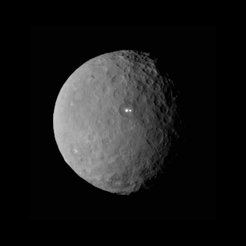Dawn: Two new glimpses of dwarf planet Ceres
Very different craters cover the surface of dwarf planet Ceres, as can be seen in recent images taken by NASA's Dawn spacecraft.

New images of dwarf planet Ceres show the full range of different crater shapes that can be found on its surface: from shallow, flattish ones to those with impressive central mountains in the middle. These two images where taken on 19 February 2015 from a distance of 46000 kilometers by the Framing Camera on board NASA's Dawn spacecraft and show similar sections of Ceres' surface as did those published last week. Due to the shorter distance between Ceres and Dawn compared to last week, many details now emerge even more clearly.
The steep slope, for example, that was already visible last week, now turns out to be part of the rim of a large crater with a diameter of approximately 300 kilometers (left image, lower half). The surface inside the crater appears very smooth and disrupted by only few smaller craters. "This suggests that the large crater is the remnant of a comparatively young impact," explains Michael Schäfer, Dawn scientist at the Max Planck Institute for Solar System Research (MPS) in Germany.
Amidst many smaller craters a central mountain can be discerned. Such formations are also found on the Earth's moon and other planets.
"During the course of the mission, the craters will enable us to take an indirect look into Ceres' interior“, says Andreas Nathues from the MPS, Framing Camera Lead Investigator. "The way the impactors deform the dwarf planet's subsurface and the way the subsurface reacts to this on long time scales allows conclusions about the material hidden beneath the topmost layer," says geologist Schäfer. In the coming weeks and months, the researchers therefore intend to precisely survey Ceres' surface structures.

In the current images, Ceres' bright spots also stand out more clearly than in earlier images. However, they are so small that their precise shape cannot yet be made out. The new Framing Camera data has a resolution of approximately four kilometers on Ceres' surface. "The brightest one of these spots continues to be too small to resolve with our camera but despite its size it is brighter than anything else on Ceres“, says Nathues.
Dawn's mission to Vesta and Ceres is managed by the Jet Propulsion Laboratory for NASA's Science Mission Directorate in Washington. Dawn is a project of the directorate's Discovery Program, managed by NASA's Marshall Space Flight Center in Huntsville, Alabama. UCLA is responsible for overall Dawn mission science. Orbital ATK, Inc., of Dulles, Virginia, designed and built the spacecraft. JPL is managed for NASA by the California Institute of Technology in Pasadena. The framing cameras were provided by the Max Planck Institute for Solar System Research, Gottingen, Germany, with significant contributions by the German Aerospace Center (DLR) Institute of Planetary Research, Berlin, and in coordination with the Institute of Computer and Communication Network Engineering, Braunschweig. The framing camera project is funded by the Max Planck Society, DLR, and NASA.

